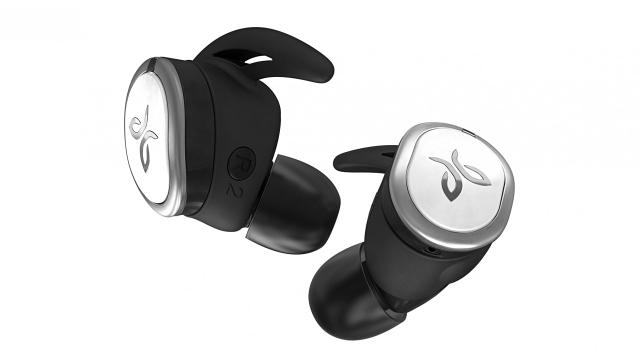Wireless earbuds are all the rage right now. And there’s a good reason for that — wires are annoying. Jaybird has a new pair of truly wire-free Bluetooth ‘buds called the RUN, and it shouldn’t take you too long to guess what they’re made for.

Jaybird Run
PRICE
$249
LIKES
Good sound, excellent fit, custom EQs
DISLIKES
Troublesome Bluetooth, bulky case
What Is It?
The $249 Jaybird RUN are truly wireless, fitness-focused earbud headphones in the vein of the Apple AirPods, Samsung Gear IconX, Jabra Elite Sport and the like. They don’t have any cables, with each of the two earbuds their own self-contained battery plus tiny speaker driver plus all the necessary smart wireless tech to talk to your phone and to each other. A bunch of different silicon tips and wings let you customise the fit for your ears individually, too.
The RUN headphones each promise four-plus hours of playable battery life, with the included hard pill-shaped battery case promising two extra charges to give you 12 hours of total listening before you need a complete recharge. A five-minute stint in the case, too, is good for another hour of playback. That battery case is quite bulky, but the headphones themselves are quite small as wireless earbuds go, measuring 14.3×19.5x19mm and weighing just 6.83g individually. They’re sweatproof and water resistant as well, so you should be able to take them out for a jog in the rain without any drama.
What’s It Good At?
For small, battery-powered wireless earphones, the Jaybird RUN sound pretty damn good. Straight out of the box in the flat audio profile there’s impressive bass response, good detail throughout the mids and highs, and nice clarity without any noticeably harsh sibilance. Bass is often my biggest concern in wireless earbuds, because it’s representative of both a tight seal and decent battery power for those tiny speaker drivers, and the Jaybird RUN delivers every bit as strongly as my current fave ‘phones, the Jabra Elite Sport. They don’t hit incredibly singingly high high notes, but they’re wireless earphones in the first place, so you can’t expect the clarity of wired.
Comfort, too, is a big part of any all-in-one earbud. The hook of the RUN isn’t that they’re especially small — the sleek earpiece and elongated stem of the Apple AirPods is actually easier on my ear cartilage — but that they’re extremely customisable. In the box, you get four pairs of silicon ear-wings (one of which doesn’t have a wing at all) and four silicon ear-tips, so any combo of each of these should give you a reasonably comfortable listening experience over long sessions. I listened to the RUNs a couple of times from full battery to empty — around three and a half hours at my preferred slightly-louder-than-normal listening level — and didn’t hate the fit by the end.
You can adjust the equaliser settings of the Jaybird RUN through the company’s complementary MySound app, too, which lets you tweak the sound in five different points across the frequency range from low to high (20, 110, 630, 3500 and 20,000Hz) to drive some extra treble clarity or bass power. I found that a moderate bump in the low end, a tiny drawing back in the midrange and a slight bump in the high end gave a more energetic and punchy sound, better for beat-driven music and beat-driven exercise. You can save presets, you can set genres that your EQ is most appropriate for, you can use one of Jaybird’s own presets. It’s all you could want from a companion app.
What’s It Not Good At?
Bluetooth reliability is the Jaybird RUN’s biggest problem. Because these wireless earbuds only have tiny batteries, they can’t power a powerful Bluetooth receiver — and that means your phone better be within as close a range to the right RUN headphone as possible. If you’re wearing it on your arm and going for a run, it’s great — the same is true if you hold your phone in your hand. But at your waistband or further away, especially if your phone isn’t on the right side of your body, it’s not a surefire thing that these earbuds will actually sync up consistently. If you’ve got something else in your right front pocket, you’ll have to move it if you want a strong connection.
Bluetooth connectivity between the two buds themselves is the Jaybird RUN’s second biggest problem. Because the Jaybird RUN uses Bluetooth to communicate between the right (primary) earbud and the left (secondary) earbud, rather than the proprietary wireless of other brands (Bragi and some others use near field magnetics to transfer data through your head), and at extremely low power and short range, these headphones are susceptible to interference from the world around you. If you’re out walking through the city, you will almost certainly notice a couple of drop-outs where the left earbud (and sometimes the right) drops out for a second — it’s not fun. It’s not a dealbreaker because it’s not always happening, but it’s not fun.
The build quality of the Jaybird RUN stands up to my limited use and abuse, but there are wireless earbuds out there that feel better built and sturdier. Most of the exposed earphone is plastic and feels a little bit cheap to the touch. I compare them to the rubberised Elite Sport and one definitely feels more premium, albeit at a $80 price bump. The relative bulk of the battery case — it’s definitely not huge, but it’s larger and a less comfortable shape than both the svelte AirPods and the squared-off Jabra Elite Sport — might also be a concern for you if you’re going to be pocketing them around town on a regular basis.
Should You Buy It?
The sound that the $249 Jaybird RUN produces is these wireless earbuds’ biggest selling point. They sound good! And they let you customise their sound even more to your tastes if you install the complementary app. Most wireless earbuds sound a bit trash, but Jaybird joins the select few that aren’t. They’re also comfortable out of the box, and can be made more comfortable if you want to put in the time and effort to try out each of the ear-wings and ear-tips that suit your particular ears.
But the wireless problem is a difficult hurdle to overcome, when there are competitors out there that don’t have this issue anywhere near as frequently. The Bluetooth works just fine most of the time, and they sound great for the price — but my recommendation would be to try them before you buy them, preferably in the area where you’re going to be using them the most. If it’s in a built-up area or a busy part of the city, you might just be better served with something else.
